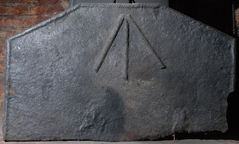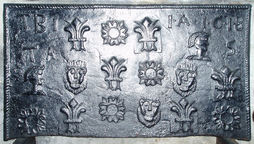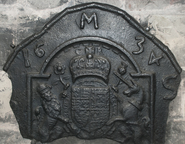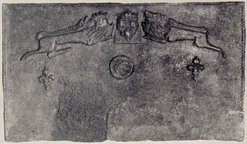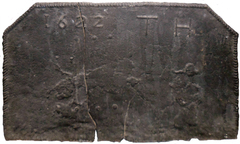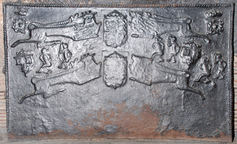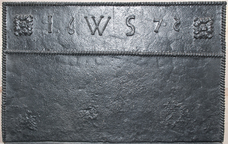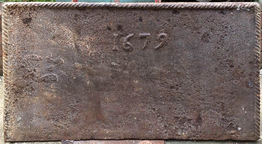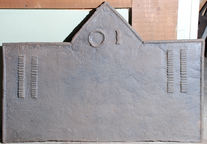-
921
Description: Canted rectangle; twisted rope edging (top and sides); central arrow-shaped design formed of three repeated rope lengths.
Notes: The arrow design probably has an apotropaic (evil-averting) purpose, perhaps intended as the initials VV for 'virgo virginum'.
- Decoration tags:
- rectangular with canted top corners (shape)
- rope (edging)
- simple stamps
- apotropaic
- objects
Manufactured: in the 16th century in the Weald area of England.
Current location: in private hands, Heathfield, East Sussex, England.
- Attached to series:
- Rope design firebacks
-
192
Description: Rectangular; twisted rope edging (top and sides); irregular arrangement of four stamps in three rows: face mask with ?crown and ruff (3), flower head with four petals and leaflets (4), fleur de lys (5), and profile of a head with 'Roman' crest (2); initials replace stamps in top corners.
Notes: A larger variant, undated and with other initials but the same four stamps, is also known.
Inscription: TBI I•A•1•6•1•8 / TA S
- Decoration tags:
- rectangular (shape)
- rope (edging)
- carved stamps
- individual letters
- individual numbers
- heraldic
- text
- humans
- plants
Manufactured: in 1618 possibly in the Weald area of England.
Current location: Godolphin House, Helston, Cornwall, England.
Museum number: 169481 (part of the National Trust museum group)
- Attached to series:
- Primitive stamp series
-
1076
Description: Fragment; arched rectangular fireback with embattled, cavetto-moulded edging; English Stuart royal shield, Garter, crown and supporters, stemmed rose and stemmed thistle, respectively, to left and right of crown; initials CR above crown; all within a plain border, with short lengths of twisted rope edging containing, at the top, the initial M between a split date; initials (only S surviving) below date.
Notes: A Carolean composite fireback. The armorial fireback includes stylistic elements - the form of the unicorn and of the harp - identical to those on two series of firebacks dated 1618 and 1619, indicating the work of the same pattern-maker; its width is 490mm.
Inscription: M / 1634 / [?] S / C R
Arms: English Stuart royal (Charles I)
- Decoration tags:
- rounded arched (shape)
- rope (edging)
- carved pattern panels
- composite
- individual letters
- individual numbers
- heraldic
- armorial
- text
Manufactured: in 1634 possibly in the Forest of Dean area of England.
Current location: Black and White House Museum, The Old House, High Town, Hereford, Herefordshire, England.
-
1174
Description: Rectangular; twisted rope edging (top and sides); top centre, crowned shield bearing initials, KH, above a fleur-de-lys, between a leopard passant guardant sinister (on the left) and a leopard passant (on the right); below the rear legs of each leopard, a fleur-de-lys, each inclined slightly outwards at the top; beneath, and slightly to the left of the shield a circular stamp bearing the letter C.
Notes: One of the legs of the leopard on the right is missing, suggesting that the stamps, which appear complete on many firebacks, were well used and had been damaged; this suggests a relatively late use of these stamps. The style of fleur-de-lys is one of two seen on this series of firebacks. The fireback was formerly at Marden Hill House, Tewin, Hertfordshire.
Inscription: C
- Decoration tags:
- rectangular (shape)
- rope (edging)
- carved stamps
- heraldic
- royal
- text
- animals
- objects
Manufactured: in the mid- to late-16th century in the Weald area of England.
Current location: Hertford Museum, 18 Bull Plain, Hertford, Hertfordshire, England.
Museum number: HETFM2893.2 (part of the Hertford Museum museum group)
- Attached to series:
- Royal series
-
1176
Description: Canted rectangular shape; twisted rope edging (top and sides); top left, date 1622; top right, initials T H.
Notes: The surface excrescences on the lower half of the fireback are likely to have resulted from the displacement of the casting sand by the pouring of the iron. Formerly at Marden Hill House, Tewin, Hertfordshire. There is no basis for the suggestion by Hertford Museum that this fireback might have been cast by a Thomas Hogge.
Inscription: 1622 T H
- Decoration tags:
- rectangular with canted top corners (shape)
- rope (edging)
- simple stamps
- carved stamps
- individual letters
- individual numbers
- text
Manufactured: in 1622 possibly in the Weald area of England.
Current location: Hertford Museum, 18 Bull Plain, Hertford, Hertfordshire, England.
Museum number: HETFM2893.1 (part of the Hertford Museum museum group)
- Attached to series:
- Date & initials firebacks
-
322
Description: Rectangular; rope edging (top and sides); two central crowned Tudor shields, one above the other, each with lion passant guardant sinister to the left, and lion passant to right; crowned, barbed, four-petalled rose in right and left corners; two crowned shields with KH in Lombardic characters above a fleur de lys, each irregularly placed between lions on left and right sides; three 'imps' with right arm raised, two on right and one on left between lions; two ‘imps’ with both arms lowered, one on each side in similar positions.
Notes: One of the legs of the leopards on the right is missing, suggesting that the stamp, which appears complete on many firebacks, was well used and had been damaged; this suggests a relatively late use of these stamps. The same heraldic charges can be seen on other firebacks, with other charges, forming the decoration on many other firebacks, suggesting they were the stock of one particular furnace.
Arms: Tudor royal arms of England
- Decoration tags:
- rectangular (shape)
- rope (edging)
- carved stamps
- heraldic
- armorial
- royal
- animals
Manufactured: in the mid- to late-16th century in the Weald area of England.
Current location: Hever Castle, Hever, Kent, England.
- Attached to series:
- Royal series
-
1271
Description: Rectangular shape; twisted rope edging (top and sides only); central initials, WS, in different character sets, between split date, also in different numeral sets, with a rectangular floral patera repeated at each end; below, and at a slight incline to the right, a horizontal twisted rope dividing the plate. The '5' of the date has been stamped in reverse.
Notes: A boldly cast fireback with disparate character styles. Probably acquired for the castle in the early-20th century during its refurbishment for Edward Hudson by Edwin Lutyens.
Inscription: 1 6 W S 7 5 [5 reversed]
- Decoration tags:
- rectangular (shape)
- rope (edging)
- simple stamps
- carved stamps
- individual letters
- individual numbers
- text
- plants
Manufactured: in 1675 in England.
Current location: Lindisfarne Castle, Holy Island, Northumberland, England.
Museum number: 511616 (part of the National Trust museum group)
- Attached to series:
- Date & initials firebacks
- Miscellaneous stamp firebacks
-
1232
Description: Rectangular; twisted rope edging on top and sides; date placed slightly right of centre near top.
Notes: A similar fireback with slightly different proportions has the same date using the same numerals.
Inscription: 1679
- Decoration tags:
- rectangular (shape)
- rope (edging)
- carved stamps
- individual numbers
- text
Manufactured: in 1679 in the Weald area of England.
Current location: not known.
- Attached to series:
- Date only firebacks
- 1679 Wealden series
-
333
Description: Rectangular with triangular extension at middle of top edge; rope edging (top and sides); inscription in triangle - O larger than I; a pair of vertical, parallel ratchet bars (180mm long) below each top corner.
Inscription: O I
- Decoration tags:
- rectangular with triangular arch (shape)
- rope (edging)
- simple stamps
- text
- objects
Manufactured: in the late-16th to early-17th century possibly in the Weald area of England.
Current location: Horsham Museum, Causeway, Horsham, West Sussex, England.
(part of the Horsham Museum museum group)
- Attached to series:
- Miscellaneous stamp firebacks
-
1126
Description: Canted rectangular shape; twisted rope edging (top and sides); cavetto-moulded-edged rectangle top centre, enclosing date between initials CT; five shields of Ayloffe impaling Sulyard in two rows (3-2); Ayloffe: sable, a lion rampant Or, collared gules, between three crosses formy of the second; Sulyard: argent, a chevron gules between three pheons inverted sable.
Notes: William Ayloffe (c1535-1584) of Bretons, Hornchurch, Essex, Justice of the Court of Queen’s Bench, married (c1560) Jane, dau. of Sir Eustace Sulyard, of Runwell, Essex. The initials 'CT' are likely to be those of Charles Tyler, a founder whose working life and that of his family have strong parallels with the occurrence of these firebacks. The smallest dated example in this series.
Inscription: C.1.6.0.9.T
Arms: Ayloffe impaling Sulyard (William Ayloffe of Bretons, Hornchurch)
- Decoration tags:
- rectangular with canted top corners (shape)
- rope (edging)
- carved stamps
- individual letters
- individual numbers
- heraldic
- armorial
- text
Manufactured: in 1609 possibly at Bedgebury Furnace, Goudhurst in the Weald area of England.
Current location: The Crown Inn, The Green, Horsted Keynes, West Sussex, England.
- Attached to series:
- Ayloffe series
- Personal armorial firebacks
